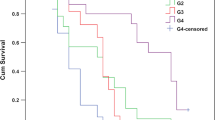Abstract
Background
We conducted a prognostic analysis of preoperative parameters and Ki-67 determination to develop selection criteria for cytoreductive surgery (CRS) and HIPEC in patients with diffuse malignant peritoneal mesothelioma (DMPM).
Methods
DMPM patients treated with CRS and HIPEC at NCI of Milan participated in this study. Multivariate analysis was conducted using Cox proportional hazard model and conditional inference tree method to select independent predictors of overall survival (OS) from the followings pre-cytoreduction parameters: age, sex, ECOG performance status, Charlson comorbidity index, previous systemic chemotherapy, CA-125, histological subtype (epithelioid vs. biphasic/sarcomatoid), Ki-67 (determined with immunohistochemistry), and peritoneal cancer index (PCI).
Results
A total of 117 patients (male/female: 67/50) with median age of 60.5 (range 22–75) years were included. Eighty-three patients had ECOG performance status = 0, median Charlson comorbidity index was 4 (range 2–9), and 102 cases had epithelioid subtype. Median Ki-67 was 5 % (range 1–60). Ninety-four (80.3 %) cases were optimally cytoreduced. The Cox analysis identified Ki-67, PCI, and histological subtype as independent prognosticators of OS. Conditional inference tree method identified three prognostic subsets: (I) Ki-67 ≤ 9 %; (II) Ki-67 > 9 % and PCI ≤ 17; and (III) Ki-67 > 9 % and PCI > 17. The median OS for subsets I, II, and III were, 86.6, 63.2, and 10.3 months, respectively.
Conclusions
Ki-67 is a powerful prognosticator that allows, along with PCI, and histological subtype, a good prediction of OS in patients with DMPM. Patients with Ki-67 > 9 % and PCI > 17 are unlikely to benefit from the procedure and should be considered for other treatment protocols.



Similar content being viewed by others
References
Robinson BW, Musk AW, Lake RA. Malignant mesothelioma. Lancet. 2005;366:397–40.
Yang H, Testa JR, Carbone M. Mesothelioma epidemiology, carcinogenesis and pathogenesis. Curr Treat Options Oncol. 2008;9:147–157.
Moore AJ, Parker RJ, Wiggins J. Malignant mesothelioma. Orphanet J Rare Dis. 2008;3:34.
Antman KH, Osteen RT, Klegar KL, et al. Early peritoneal mesothelioma: a treatable malignancy. Lancet. 1985;2:977–81.
Eltabbakh GH, Piver MS, Hempling RE, Recio FO, Intengen ME. Clinical picture, response to therapy, and survival of women with diffuse malignant peritoneal mesothelioma. J Surg Oncol. 1999;70:6–12.
Helm JH, Miura JT, Glenn JA, et al. Cytoreductive surgery and hyperthermic intraperitoneal chemotherapy for malignant peritoneal mesothelioma: a systematic review and meta-analysis. Ann Surg Oncol. 2015;22:1686–93.
Schaub NP, Alimchandani M, Quezado M, et al. A Novel Nomogram for Peritoneal Mesothelioma Predicts Survival. Ann Surg Oncol. 2013;20:555–61.
Deraco M, Cabras A, Baratti D, Kusamura S. Immunohistochemical evaluation of minichromosome maintenance protein 7 (MCM7), topoisomerase IIα, and Ki-67 in diffuse malignant peritoneal mesothelioma patients using tissue microarray. Ann Surg Oncol. 2015. doi:10.1245/s10434-015-4498-z.
Yan TD, Haveric N, Carmignani CP, Chang D, Sugarbaker PH. Abdominal computed tomography scans in the selection of patients with malignant peritoneal mesothelioma for comprehensive treatment with cytoreductive surgery and perioperative intraperitoneal chemotherapy. Cancer. 2005;103:839–849.
Deraco M, Santoro N, Carraro O, et al. Peritoneal carcinomatosis: feature of dissemination. A review. Tumori. 1999;85:1–5.
Deraco M, Baratti D, Kusamura S, et al. Surgical technique of parietal and visceral peritonectomy for peritoneal surface malignancies. J Surg Oncol. 2009;100:321–8.
Rossi CR, Foletto M, Mocellin S, et al. Hyperthermic intraoperative intraperitoneal chemotherapy with cisplatin and doxorubicin in patients who undergo cytoreductive surgery for peritoneal carcinomatosis and sarcomatosis: phase I study. Cancer. 2002; 94:492–499.
Deraco M, Baratti D, Hutanu I, Bertuli R, Kusamura S. The role of perioperative systemic chemotherapy in diffuse malignant peritoneal mesothelioma patients treated with cytoreductive surgery and hyperthermic intraperitoneal chemotherapy. Ann Surg Oncol. 2013;20:1093–100.
Charlson ME, Pompei P, Ales KL, MacKenzie CR. A new method of classifying prognostic comorbidity in longitudinal studies: development and validation. J Chron Dis. 1987;40:373–383.
Mery É, Hommell-Fontaine J, Capovilla M, et al. Peritoneal malignant mesothelioma: review and recent data. Ann Pathol. 2014;34:26–33.
Younan R, Kusamura S, Baratti D, et al. Morbidity, toxicity, and mortality classification systems in the local regional treatment of peritoneal surface malignancy. J Surg Oncol. 2008;98:253–7.
Royston P, Sauerbrei W. Building multivariable regression models with continuous covariates in clinical epidemiology—with an emphasis on fractional polynomials. Methods Inf Med. 2005;44:561–71.
Harrell FE Jr, Lee KL, Mark DB. Multivariable prognostic models: Issues in developing models, evaluating assumptions and adequacy, and measuring and reducing errors. Stat Med. 1996;15:361–87.
Efron B, Tibshirani RJ. An introduction to the bootstrap. Chapman and Hall, Springer Science, New York, 1993.
Hothorn T ZH. Unbiased recursive partitioning: a conditional inference framework. J Comput Graph Stat. 2006;15:651–74.
Baratti D, Kusamura S, Cabras AD, Bertulli R, Hutanu I, Deraco M. Diffuse malignant peritoneal mesothelioma: long-term survival with complete cytoreductive surgery followed by hyperthermic intraperitoneal chemotherapy (HIPEC). Eur J Cancer. 2013;49:3140–8.
Yan TD, Deraco M, Baratti D, et al. Cytoreductive surgery and hyperthermic intraperitoneal chemotherapy for malignant peritoneal mesothelioma: multi-institutional experience. J Clin Oncol. 2009;27:6237–42.
Harrell FE Jr. Regression modeling strategies with applications to linear models, logistic regression, and survival analysis. New York, Springer, 2001.
Royston P, Altman DG, Sauerbrei W. Dichotomizing continuous predictors in multiple regression: a bad idea. Stat Med. 2006; 25:127–141.
Gouy S, Belghiti J, Uzan C, Canlorbe G, Gauthier T, Morice P. Accuracy and reproducibility of the peritoneal cancer index in advanced ovarian cancer during laparoscopy and laparotomy. Int J Gynecol Cancer. 2013;23:1699–703.
Nonaka D, Kusamura S, Baratti D, et al. Diffuse malignant mesothelioma of the peritoneum: a clinicopathological study of 35 patients treated locoregionally at a single institution. Cancer. 2005; 104:2181–88.
Acknowledgment
This study was partially supported by AIRC (Associazione Italiana per la Ricerca Contro il Cancro).
Conflict of interest
The authors declare that there is no conflict of interest.
Financial support
The present work did not receive any financial support.
Author information
Authors and Affiliations
Corresponding author
Rights and permissions
About this article
Cite this article
Kusamura, S., Torres Mesa, P.A., Cabras, A. et al. The Role of Ki-67 and Pre-cytoreduction Parameters in Selecting Diffuse Malignant Peritoneal Mesothelioma (DMPM) Patients for Cytoreductive Surgery (CRS) and Hyperthermic Intraperitoneal Chemotherapy (HIPEC). Ann Surg Oncol 23, 1468–1473 (2016). https://doi.org/10.1245/s10434-015-4962-9
Received:
Published:
Issue Date:
DOI: https://doi.org/10.1245/s10434-015-4962-9




